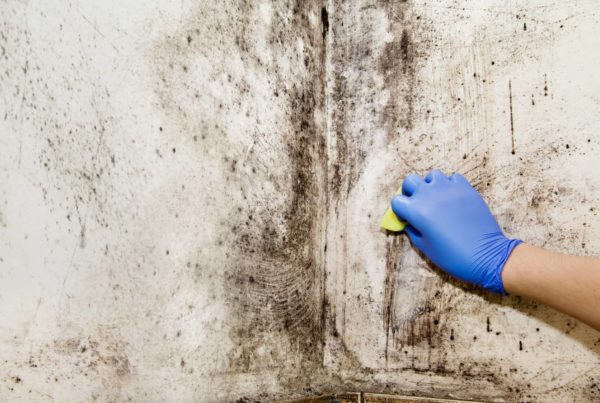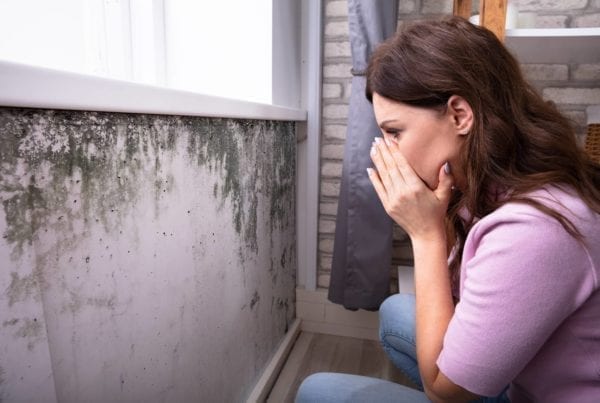
Today, we are discussing how to test for mold. We will go into detail about what mold is, how it grows, how to test, and what to do about it.
Let’s get started!
What Is Mold
Mold is a fungus that is everywhere and can be a variety of colors. It is okay to inhale in small amounts and typical. However, sometimes mold can grow out of control in your home through moisture and material to grow on (can be drywall, wood, or dust in the air).
If you are sensitive to mold or have prolonged heavy mold exposure, it could make you sick.
Where Does Mold Grow?
Mold can grow anywhere with high moisture and a food source. Common areas are:
- Roof leak areas.
- Plumbing leak areas.
- Water intrusion areas.
- Around air handlers.
- Basements.
- Attics.
It’s important to find the water leak source when testing for mold. Solving the water leak typically solves the mold issue. Unless the source is from your air conditioner, then you will need to call an HVAC technician.
Symptoms of Prolonged Mold Exposure
Some people are more sensitive to mold as mentioned before. Additionally, prolonged mold exposure can make you sick. These are the symptoms of prolonged mold exposure or mold allergy.
- Sneezing.
- Runny or stuffy nose.
- Cough and postnasal drip.
- Itchy eyes, nose, and throat.
- Watery eyes.
- Dry, scaly skin.
If you believe you have exposed to mold, read more about how to test for mold and what to do about it.
How You Can Test For Mold
Homeowners can easily test for mold in their home with an at-home test kit purchased from their local Home Depot (or Lowe’s) or from Amazon. We recommend the ProLab Test Kit for Air and Surface Testing (not sponsored). We actually use ProLab for our professional testing!
The test kit allows you to test for mold in the air or on surfaces. After completing the test, you can submit the test kit to their lab ($40 charge), and ProLab will send you detailed results as well as help you read the results.
How To Test For Mold Video
Please keep in mind, this YouTuber is using a different test for mold than what we recommended above. Continue on after the video to find out what to do after you complete the test.
Thing To Remember When Testing For Mold
Please understand mold is everywhere so sometimes reading the test results can be confusing. Reaching out to ProLab can help you understand what is going on.
Moreover, just because you swabbed for mold or there is mold in the air, does not necessarily mean you have an issue. If the space of mold is less than 10 square feet, you can clean the mold with a 50/50 solution of water and vinegar, then monitor if it comes back.
If you have a persistent mold issue, are unaware of what the cause is, or have any doubts, please call your local (and highest-rated) home/mold inspector. They are there to help you!
How We Test For Mold
Home Inspectors are like general practitioners for your home. They can look at every aspect of your home’s construction and tell if there is an issue. This includes, knowing if there is a mold issue in your home.
Why Test for Mold
When purchasing a home, it can be a great idea to do mold air quality testing. Considering you have no idea how well the sellers have lived or maintained the home, the air quality can be in question.
Furthermore, home inspectors can do mold testing for you during the home inspection process. This helps saves time and money by doing it together.
Lastly, mold can sometimes be smelled or seen if there is a serious issue. However, this is not always the case. I have personally been in many homes where there was mold testing was requested and I was shocked at the amount of mold spores that came back on the tests.
Completing mold air quality testing on a home you are purchasing, is like doing your extra set of due diligence and there is no true way of knowing if there is mold growth without testing.
The Process of Testing for Mold
Typically, inspectors come with many types of equipment.
The first one is a machine. This machine is like a small vacuum that sucks in air. The second part to this type of equipment are the cassettes. The cassettes are special devices that channel the sucked in air through a slide that captures air spores.
You can see an image of one of our inspectors completing air quality testing below. The top portion is the cassette while the case is the machine.

Other forms of equipment an inspector may use are:
A moisture meter to detect moisture levels.
A humidity reader to determine the level of water in the air.
A thermometer to verify the temperature of the home.
A thermography camera to look at temperature differentials.
And general inspection equipment like a flashlight and camera.
Test for Mold Process
When the inspector arrives, they can conduct an exterior sample first. This air sample is known as the control which is used as a comparison for the air quality inside the home. Each sample takes about 10 minutes to complete.
Next, the inspector will conduct interior samples of the home. The amount of interior samples to be taken depends on the size of the home. We typically recommend 1 sample for every 1,000 square feet of space.
An inspection company will also consider the areas of concern. For instance, if only one room is a concern for mold growth, we may only conduct 2 samples of the interior of the home: 1 in the room of concern, and 1 in the living room. In most cases during a home transaction, tests are completed based on square footage.
Next in the process comes inspection and recording.
The inspector will conduct an inspection of the property. If it is with home inspection, the inspector will conduct his/her general inspection. However, if this inspection is just for mold air sampling, the inspector will look for areas of concern using their knowledge and equipment.
Here are a few places of high interest for an inspector’s mold inspection:
The Air Handler – This area typically can have a lot of mold growth especially if it unmaintained and/or the filter has not been replaced with a HEPA filter.
The Roof & Attic – A common spot for water entry through roof leaks.
Exterior walls – Another common entry point for water intrusion.
Plumbing systems – Using thermography cameras and their knowledge of construction, inspectors can find possible water leaks inside the walls.
After conducting an inspection, the data is recorded with cameras. Moreover, the air quality cassettes are labelled and shipped to a laboratory for testing.
Getting Lab Results after the Test for Mold
The lab results are typically received anywhere from 24-72 hours (depending on work days and shipping). Then, the spore counts of each sample along with its corresponding spore identification are evaluated and compared.
To know if there is a mold issue in the home, the general consensus is if there is a higher amount of mold spores inside the home, then outside, then there is a mold issue inside the home.
Using the results, the inspector can give recommendations of next steps to either remediate or state there is no concern for mold inside the home.
The Most Common Concern About Mold
Black mold is a common area of concern when it comes to mold. This type of spore is caused by a water intrusion and can grow on drywall, dust, carpets, and all types of furniture. The technical name of Black Mold is Stachybotrys chartarum.
We can test for mold, including black mold using physical swabs. Air quality testing also tests for black mold.
If you have questions on mold remediation: check out the article on when should you be concerned about mold.
Subscribe to get notified on new blogs about mold testing and remediation.
Comment below if you have any questions.



